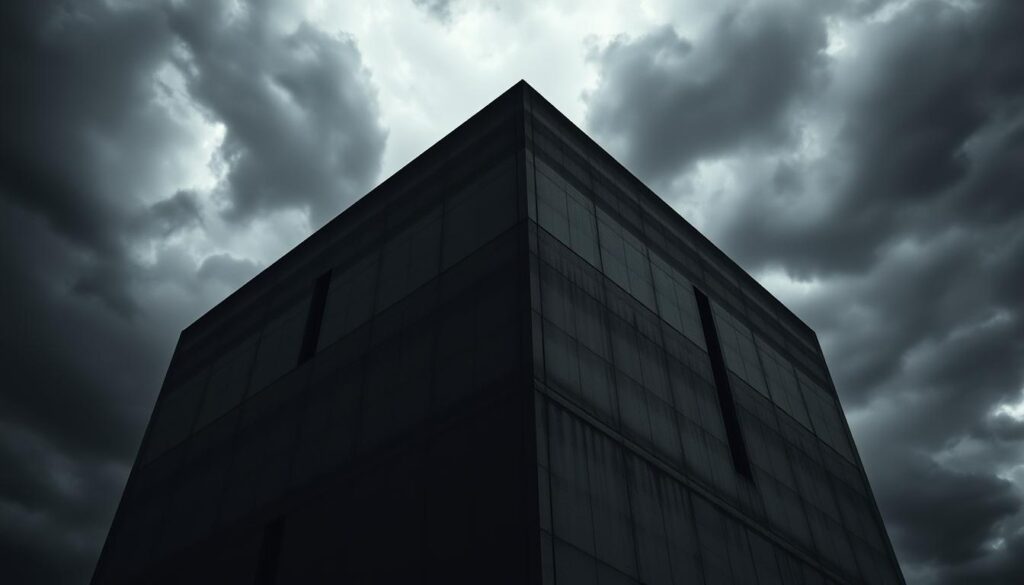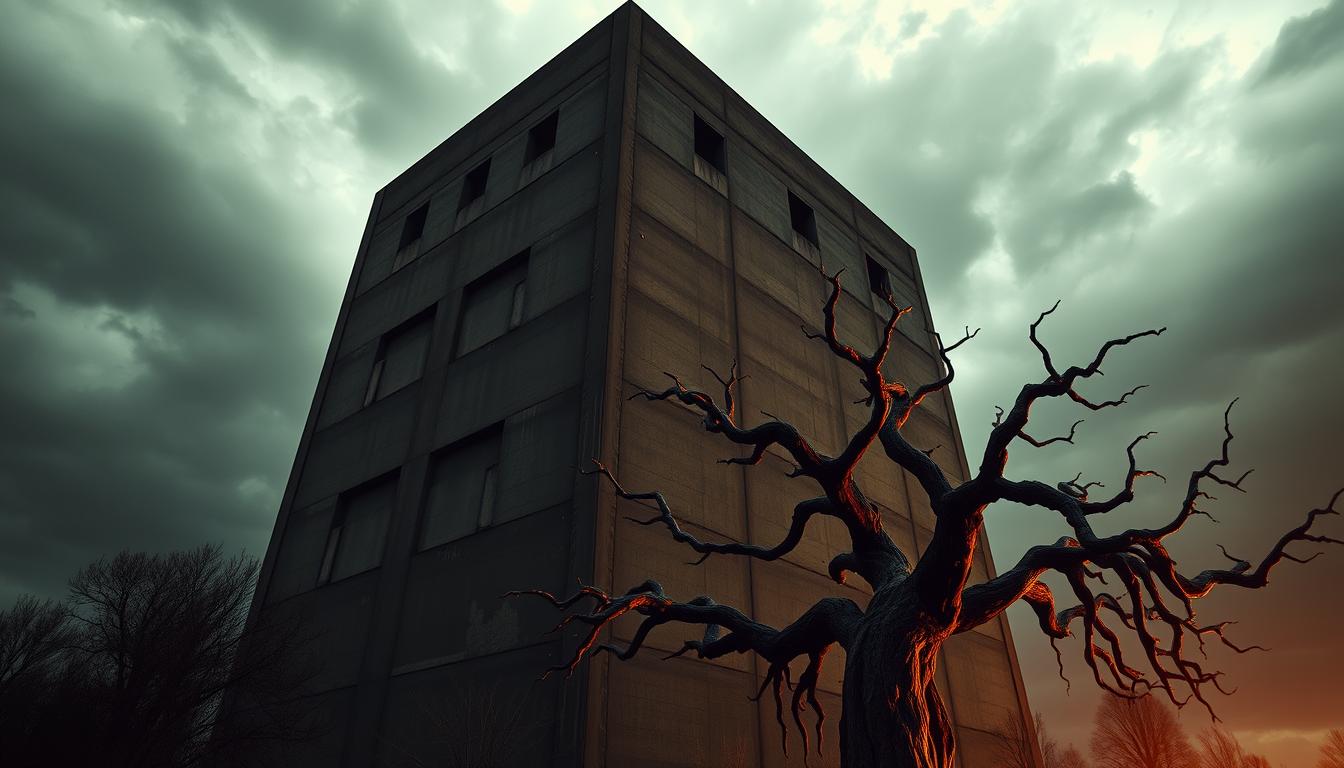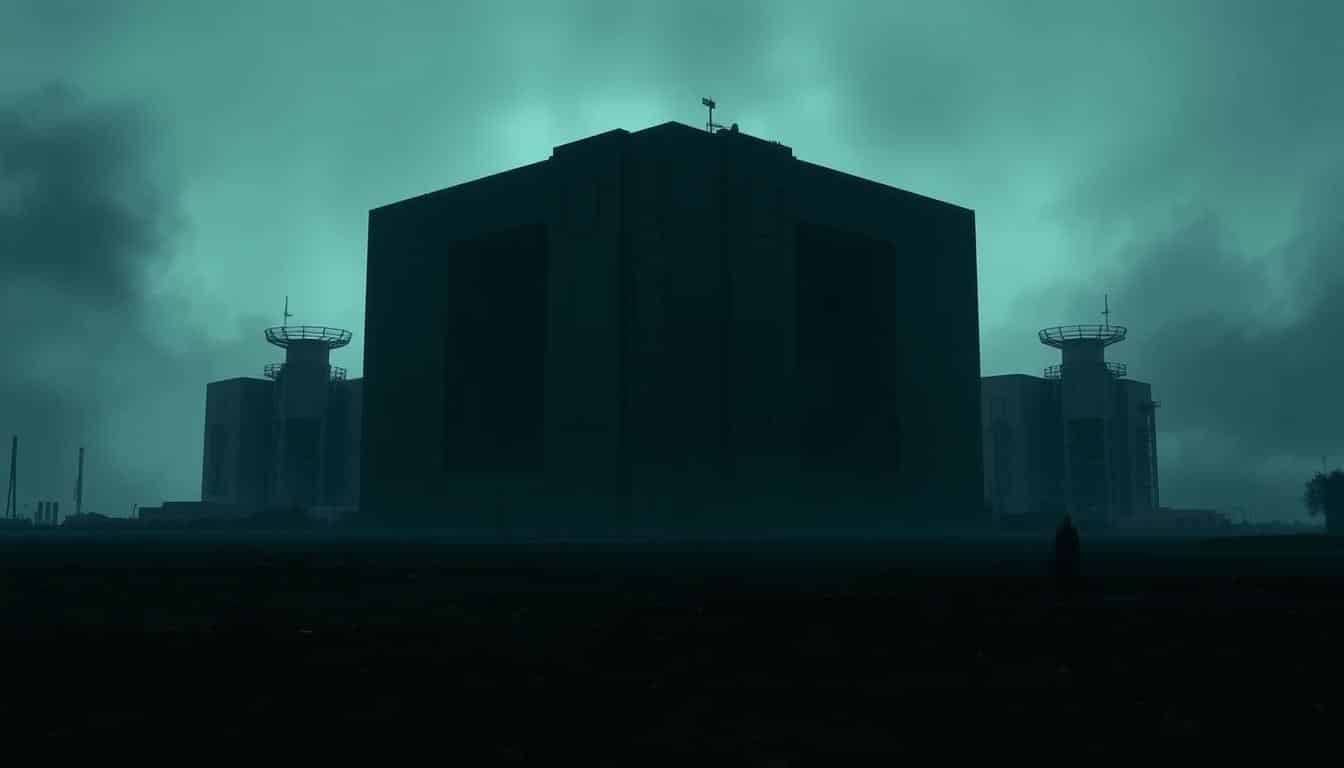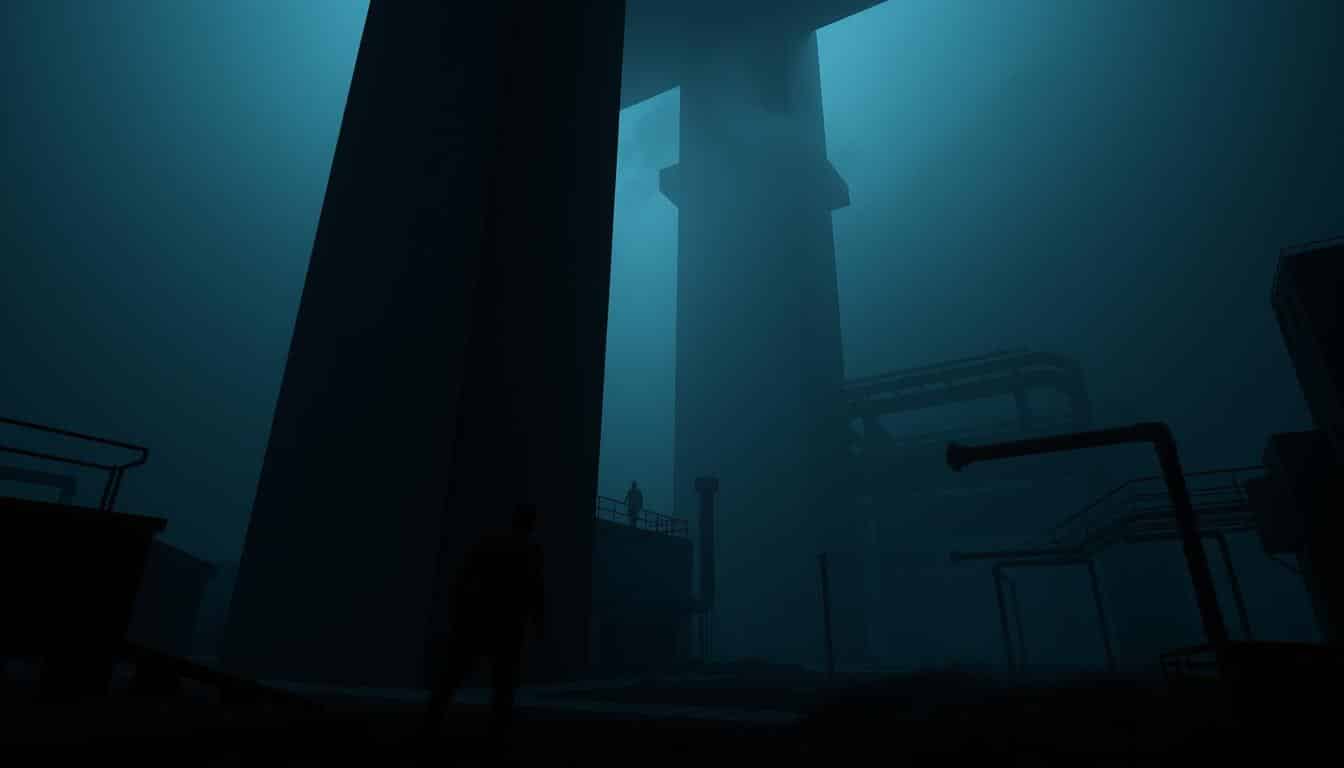In the horror world, brutalism stands out as a key element for immersive experiences. Its stark, big forms aren’t just about looks; they make you feel fear and alone. When brutalist designs meet horror stories, they create a one-of-a-kind mood.
This mood makes the story’s emotions stronger. As we explore brutalism’s role in horror, we’ll see how it sets the scene for chilling tales. These tales pull the audience into unsettling worlds, making everything more thrilling.
The Aesthetic Appeal of Brutalism in Horror
Brutalism started in the mid-20th century, combining function and raw attraction. It came about to meet the social needs back then, aiming for practical designs. Brutalist architecture has grown over time, playing a big role in horror’s look and feel. These intimidating buildings bring feelings of fear and unease, making horror stories more engaging.
The Origins of Brutalism
Starting in the 1950s, brutalism marked a bold direction in architecture with its raw concrete and simple shapes. It aimed to change traditional styles, pushing for social change and better access. Pioneers like Le Corbusier and Louis Kahn emphasized material and construction truth. Brutalism’s beginnings can be seen in:
- Its focus on social improvement through utilitarian values.
- How modernist thoughts influenced its designs.
- Its contribution to urban planning that values practicality.
The Role of Brutalism in Conveying Fear
Brutalist buildings often look deserted, perfect for adding to horror stories. Their bulkiness and sharp lines set the perfect stage for fear. This distinct trait inspires those in film and art. Brutalist architecture doesn’t just act as a setting but also as a psychological tool that:
- Makes scenes tenser with its dominating aura.
- Mirrors the inner struggles of characters.
- Questions our ideas of safety and what’s normal.

Understanding Immersive Experiences in Horror
Immersive experiences are key in horror. They let people get really into the stories. To be immersive, an experience must mix feelings and senses. A great horror makes viewers fully dive in, feeling all the scare and tension.
Defining Immersive Experiences in Entertainment
In horror, immersive experiences change how we see fear. Using sights, sounds, and touch, creators grab and keep our attention. This deep focus makes the story hit harder. When you’re totally pulled in, you can’t tell what’s real or not, making everything more intense.
The Impact of Atmosphere on Horror
The setting is crucial for immersive horror. It slowly pulls you into a world that’s scary yet appealing. With changing environments and edge-of-your-seat plots, the fear grows and keeps you hooked. As the setting gets more intense, you feel more connected. This deep dive makes horror stories really stick with us, scaring us more deeply.
Using Brutalism to Create Immersive Horror Experiences
Brutalist architecture makes horror in games and films more intense. Its bold and raw designs create spaces that feel oppressive and scary. Architectural details really pull the viewer or player into the experience on a deep, mental level.
Architectural Features that Enhance Fear
Noteworthy architectural features of brutalism include:
- Large-scale forms that make you feel small and vulnerable.
- Confusing layouts that make it hard to know where you are.
- Cold, hard materials like concrete that make surroundings feel isolated.
Together, these factors make the horror feel more real. They make you feel the tension in the air.
Examples of Brutalism in Horror Media
In the game “Control,” the Oldest House is more than just a building. It changes the game’s world and how players see it. Its stark designs and confining spaces show how the characters inside are feeling.
The movie “The Shining” also uses brutalist design. The Overlook Hotel’s sharp designs and big, empty halls make the fear grow. These examples show how important brutalist architecture is for making horror stories feel deep and real.
The Connection Between Brutalism and Psychological Fear
Brutalist architecture is more than just a style; it triggers deep fears. Its stark and tough designs make people feel vulnerable and anxious. In horror movies and games, these feelings are used to make fear more intense. Viewers face their inner frights in settings that feel isolating and oppressive.
Brutalist Spaces as Psychological Triggers
Brutalist places have large, empty areas and intimidating buildings. This can make you feel scared and lost. The way these spaces are designed affects how safe you feel. Features include:
- Massive concrete walls that seem to trap you.
- Dimly lit corridors that lead to the unknown.
- Deserted buildings that remind us of decay.
These factors make you more alert and fill the atmosphere with fear. This makes horror stories more engaging. It challenges viewers to think about themes like loss and feeling disconnected.
Case Studies: Games and Films that Utilize Brutalism
In the game Control, players wander through the Oldest House, a brutalist building. Its maze-like corridors and strange events play a big role in creating fear. This setting forces players to deal with their fears in a suffocating environment.
The Shining is a film that uses brutalism to scare both its characters and the audience. The Overlook Hotel’s large structure and barren rooms increase the story’s suspense. It shows the mental breakdown of the people inside. Brutalist designs make the horror experience more real and explore deep fears.
Brutalism in Video Games: A Case Study
“Control” is a key video game showcasing brutalism, especially with its unique setting, the Oldest House. This building displays a raw, functional style that boosts the game’s tense atmosphere. It lets players explore a world that’s always changing, linking the design to the gameplay.
Exploring the Oldest House in Control
The Oldest House is not just a setting; it’s the heart of brutalist design, with its concrete surfaces and geometric shapes. It engulfs players in a setting that’s both strange and known. While walking through its complex halls, they face odd events that add to the mystery and discomfort.
Gameplay Mechanics Enhanced by Brutalist Design
The gameplay in “Control” deeply connects to the brutalist style of the Oldest House. Features include:
- Changing environments that test how players understand space
- Altering perspectives to shift how the player sees and interacts with the game
- Stories told through the building’s design
These elements make the interaction between the player and the space dynamic. Analyzing “Control” shows that the game makes players change their strategies due to the Oldest House’s unpredictable nature. Brutalism not only makes the game a visual treat but also weaves in challenges related to its architecture.
Brutalist Design Elements That Enhance Immersion
Brutalist styles in horror build a thick air of psychological tension. They use specific design elements to create spaces. These spaces are not just scary but increase the feeling of being fully immersed in horror. The focus is on geometric shapes and color theory. These create a solid base for making environments feel unsettling.
Geometric Shapes and Stark Lines
Geometric shapes and stark lines are key in brutalist design. They make the atmosphere feel off, adding to the scare factor. These shapes and lines show how big spaces can seem and feel like a prison. This can make viewers feel trapped, raising their anxiety and feelings of vulnerability.
Color Theory in Brutalist Horror
Color theory is vital in setting the mood of a scene. Using colors that stand out against each other boosts the horror feel, affecting how viewers see and feel about a scene. A mix of dark and bright colors can bring out chaos. The smart use of colors in brutalist horror helps create an emotional setting. This setting pulls viewers into a frightening world.
The Role of Sound Design in Brutalist Horror
Sound design plays a crucial role in brutalist horror, making the experience more immersive. It uses the unique spaces to boost tension and unease. This turns simple sounds into something that really gets under your skin, affecting you deeply.
Creating Tension Through Acoustic Spaces
The use of sound in brutalist horror makes everything more intense. Sounds bounce off the cold walls and big spaces, making you feel on edge. This includes:
- Whispers that make you feel watched.
- Loud noises that make you jump.
- Background sounds that make you feel something bad will happen.
Examples from Notable Horror Games and Films
Many horror games and films show how important sound is. For example, “Silent Hill” and “A Quiet Place” really bring you into their world with sound. They turn it from just background noise into a key part of the story. This includes:
- Using quiet moments to make you expect something scary.
- Adding creepy sounds that match the scary settings.
- Changing the sounds as the story gets scarier.
How Brutalist Architecture Influences Narrative Structure
Brutalist architecture shapes the story of horror tales in a big way. These big buildings do more than set the scene. They also join in on the hero’s mental journey. In horror stories, the way Brutalist design spreads out matches the characters’ inner battles. This makes their feelings even stronger.
The Psychological Journey of the Protagonist
The hero’s journey is seen through loneliness and deep fear. This feeling is made stronger by the simple look of Brutalist places. As characters move through these heavy spaces, their strong emotions are reflected. This builds a deep link between the story the buildings tell and the depth of the mind. The roughness of the materials and the huge size of the buildings make the characters feel exposed. This makes the story’s tension even higher.
Narrative Layers Created by Architectural Choices
Choosing Brutalist architecture adds layers to horror stories. Brutalist design adds depth, letting the story explore deeper meanings. Spaces with geometric shapes and tough lines can mean barriers, being trapped, or the chaos in the hero’s mind. This way of telling stories through buildings makes the plot richer. It draws the audience in more, making the horror story more engaging.
Real-World Applications of Brutalism in Horror Experiences
The blend of brutalism and horror shows up in real-world settings like art installations and escape rooms. Artists use brutalist themes to create spaces that make visitors feel intense emotions and push their comfort zones. These experiences let people interact with the space and story in new ways, turning ordinary attractions into deep journeys.
Installation Art and Immersive Horror Exhibits
Installation art is key in creating deep horror experiences. Artists like Rebecca Horn and Kader Attia use their art to bring out feelings of fear and unease. They use the brutalist style, with its simple shapes and limited colors, to make visitors feel alone. As people walk through these artworks, they face things that scare and make them think.
Brutalist Themes in Escape Rooms
Escape rooms are now using more brutalist designs to tell thrilling stories. These rooms have a look that makes the game feel more intense. The design, with its simple lines and shadows, makes players feel trapped. This setting makes every puzzle and challenge feel even more exciting. It shows how brutalism can make horror experiences even better.
Conclusion
In our final thoughts on brutalism and horror, it’s clear that buildings shape the way stories feel. Brutalism’s hard lines, sharp shapes, and big structures make stories more gripping. They help pull us into tales that scare and fascinate us.
The mix of sound and this bold architecture increases the story’s tension and drama. This blend makes the mood stick with us much longer. It shows how key brutalism is in making us feel a certain way, affecting both characters and us.
Think about how horror movies or books have made you feel. It’s often the setting and sounds that shape your feelings. This discussion shows the power of space in horror, making the scary parts more intense. It tells us how important well-designed settings are in making stories feel real and terrifying.



